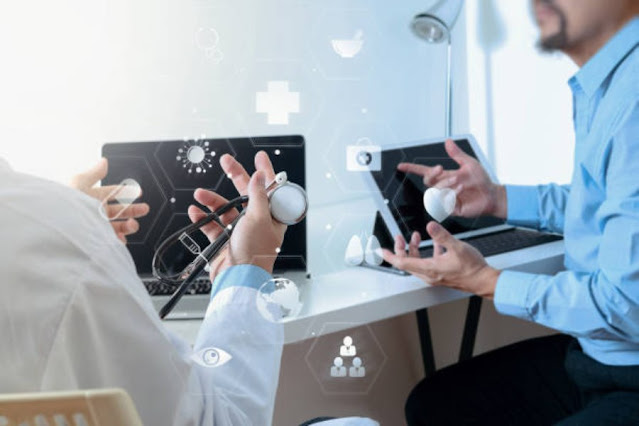Featured
- Get link
- X
- Other Apps
AI in Telehealth Support technology advancements and strategies

AI in Telehealth Support technology beauty advancements and strategies
The convergence of artificial intelligence (AI) and
telehealth has ushered in a new era of healthcare support, technological
advancements, and beauty industry strategies. This dynamic combination has not
only transformed the way medical services are delivered but has also
revolutionized consumer experiences and business operations in the beauty
sector.
Telehealth and AI: A Healthcare Revolution
Telehealth, the remote provision of healthcare services, has
gained unprecedented momentum with the integration of AI. AI-powered virtual
health assistants provide real-time medical information, answer queries, and
offer preliminary assessments to patients, enhancing access to healthcare
information and reducing the burden on medical professionals.
One of the most remarkable contributions of AI in telehealth
is its ability to facilitate remote diagnosis and monitoring. Advanced
algorithms can analyze medical images, such as X-rays and MRIs, to detect
anomalies and provide preliminary diagnoses. This has proven invaluable in
cases where specialist expertise is scarce in certain geographic areas,
enabling timely intervention and treatment.
Furthermore, AI-driven predictive analytics enable
healthcare providers to anticipate disease outbreaks, manage patient
populations, and optimize resource allocation. This proactive approach to
healthcare management improves patient outcomes and boosts the overall
efficiency of healthcare systems.
Technological Advancements: Redefining Connectivity
The synergy between AI and telehealth has paved the way for
transformative technological advancements, particularly in the realm of
connectivity. The Internet of Things (IoT) has flourished, enabling medical
devices and wearables to seamlessly transmit health data to healthcare
providers. This continuous stream of information empowers individuals to
actively participate in their health management and enables medical
professionals to provide more personalized care.
AI-powered telehealth platforms also integrate with
electronic health records, ensuring that patient information is readily
available to authorized healthcare personnel. This level of accessibility
enhances care coordination and reduces the risk of medical errors caused by
incomplete or outdated information.
Beauty Industry Strategies: AI-driven Personalization
The beauty industry has embraced AI and telehealth to create
adapted experiences that cater to individual needs and preferences. Virtual
consultations with skincare professionals or dermatologists are now possible,
allowing consumers to receive expert advice from the comfort of their homes.
AI-powered beauty apps analyze images of a person's skin,
hair, or features to provide tailored product recommendations. These apps
consider factors like skin type, tone, and concerns to suggest products that
align with an individual's unique needs.
Moreover, beauty brands leverage AI to develop virtual
try-on features that allow users to visualize how makeup or hair products will
look on them before making a purchase. This enhances the online shopping involvement
and reduces the chance of returns due to mismatched expectations.
AI Strategies and Considerations
Incorporating AI into telehealth and the beauty industry
requires thoughtful strategies and considerations. In healthcare, ensuring data
security and patient privacy is paramount. Strategies should encompass robust
encryption protocols, secure data storage, and transparent communication with
patients about how their data will be used.
For beauty brands, transparency in AI-driven recommendations
is crucial. Disclosing the algorithms used to generate product suggestions
fosters trust between consumers and brands. Moreover, as AI becomes more deeply
embedded in customer experiences, companies should prioritize the continuous
improvement of AI models to ensure accurate and relevant recommendations.
Challenges and Future Prospects
The marriage of AI and telehealth, as well as their
integration in the beauty sector, come with their share of challenges. In
healthcare, ethical concerns surrounding AI's role in making critical medical
decisions and potential bias in algorithms must be addressed. Regulatory
frameworks need to evolve to accommodate the evolving landscape of AI in
healthcare.
For beauty businesses, striking a balance between the
convenience of virtual consultations and the tactile experience of in-person
interactions remains a challenge. Companies must innovate to create immersive
virtual experiences that replicate the sensory elements of physical beauty
consultations.
The future prospects for AI in telehealth support and beauty
advancements are promising. Enhanced AI algorithms could enable even more
accurate remote diagnoses and monitoring, reducing the strain on healthcare
systems. In the beauty industry, AI could evolve to provide even more detailed
and personalized recommendations, potentially leading to the development of
custom-made beauty products.
In conclusion, the fusion of AI, telehealth, and the beauty
industry has led to a paradigm shift in how healthcare is delivered and beauty
experiences are personalized. The strategic integration of AI-driven
technologies holds immense potential to improve patient outcomes, enhance
consumer experiences, and drive innovation across sectors. However, careful
attention to ethical considerations, data security, and transparency is
essential to ensure the responsible and sustainable deployment of AI in these
domains.
- Get link
- X
- Other Apps
Popular Posts
What are some examples of technical documentation?
- Get link
- X
- Other Apps


Comments
Post a Comment